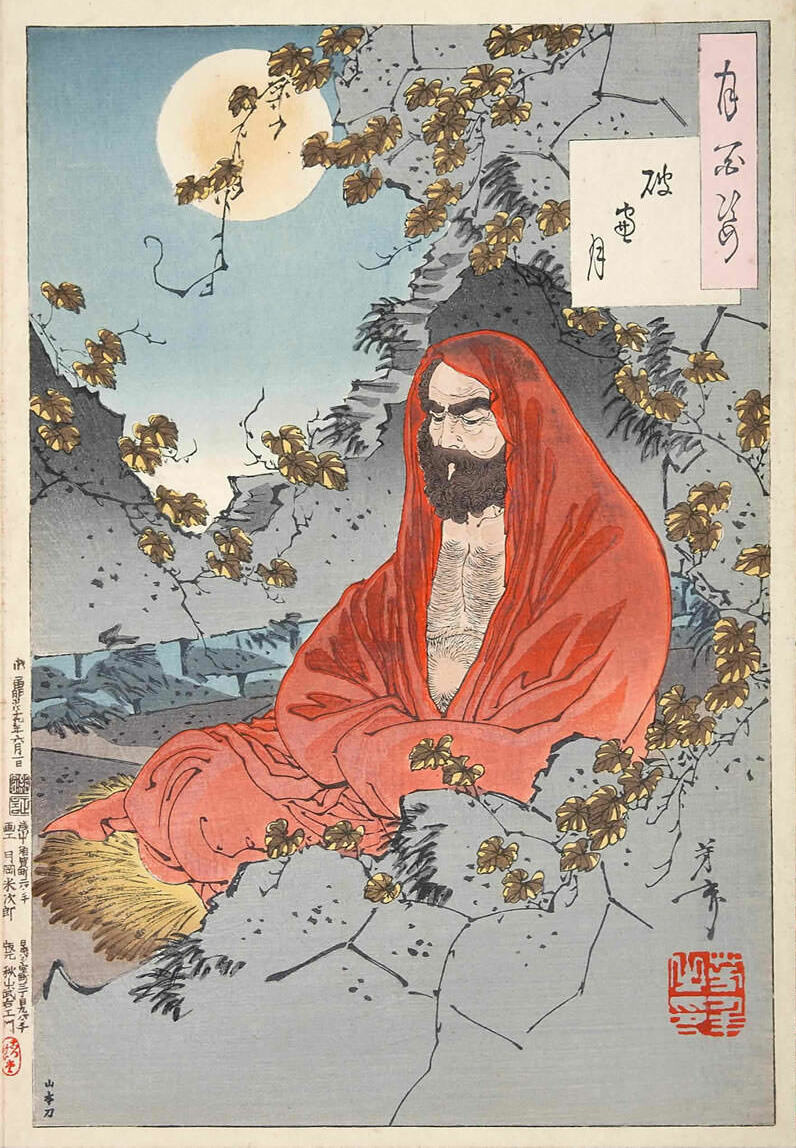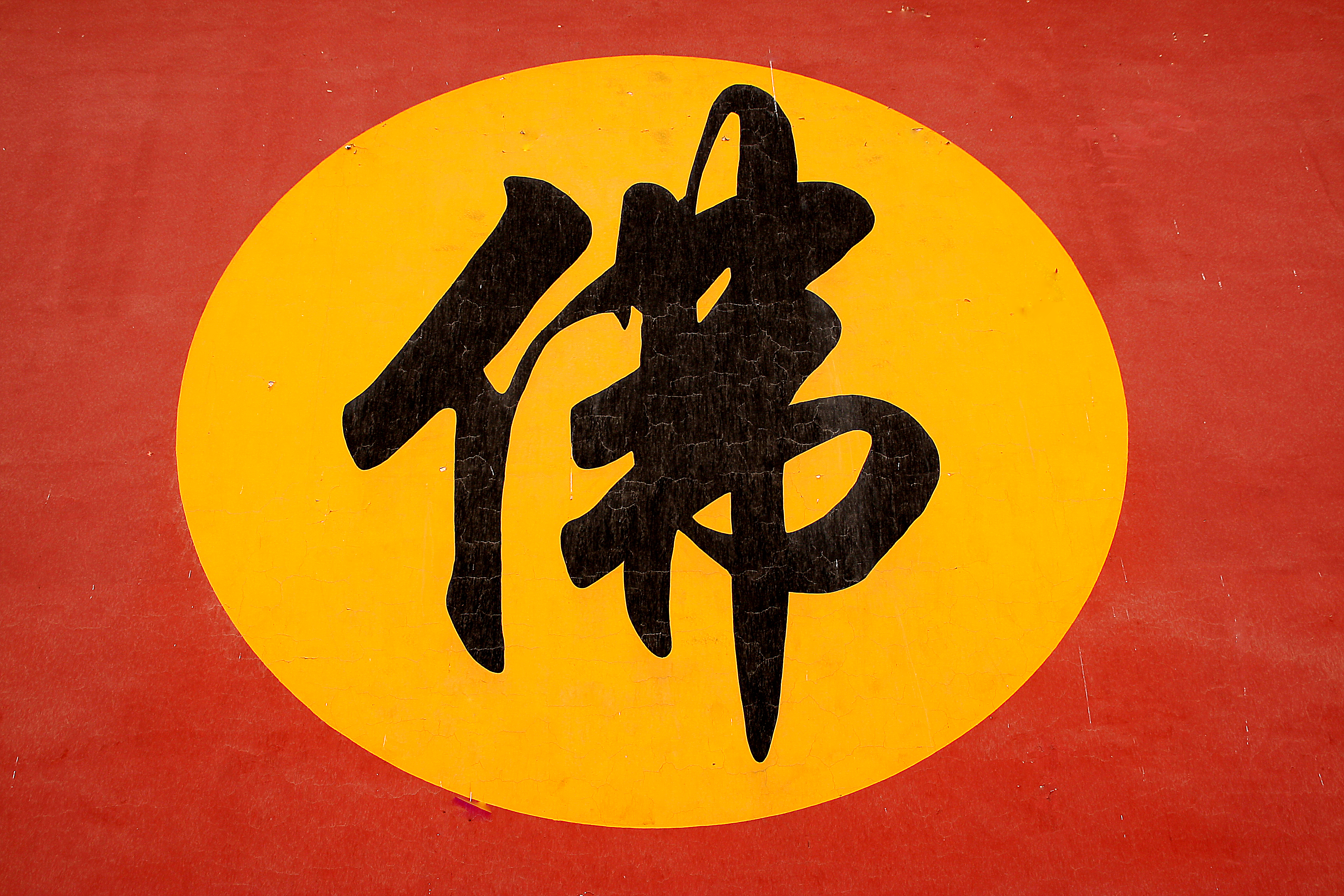|
Two Entrances And Four Practices
The Treatise on the Two Entrances and Four Practices (Chinese: 二入四行; Pinyin: ''èrrú sìxíng''; Wade–Giles: ''Erh-ju ssu-hsing''; Japanese: ''Ninyū shigyō ron'') is a Buddhist text attributed to Bodhidharma, the traditional founder of Chan (Japanese: Zen) Buddhism. History The text, sometimes referred to simply as ''The Two Entrances'', was first used in 6th century CE by a group of wandering monks in Northern China specializing in meditation who looked to Bodhidharma as their spiritual forebear. Though this text was originally attributed to Bodhidharma, a great deal of material was added to it, probably around the 8th century, by the monks or perhaps other anonymous groups. The work, along with T'an Lun's biography of Bodhidharma and other newly discovered manuscripts, was recompiled into a larger text called the ''Long Scroll'' by a renowned Japanese Zen practitioner, Daisetsu Teitaro Suzuki, in 1935. Teachings The two entrances referred to in the title are ... [...More Info...] [...Related Items...] OR: [Wikipedia] [Google] [Baidu] |
Buddhism
Buddhism, also known as Buddhadharma and Dharmavinaya, is an Indian religion and List of philosophies, philosophical tradition based on Pre-sectarian Buddhism, teachings attributed to the Buddha, a wandering teacher who lived in the 6th or 5th century Before the Common Era, BCE. It is the Major religious groups, world's fourth-largest religion, with about 500 million followers, known as Buddhists, who comprise four percent of the global population. It arose in the eastern Gangetic plain as a movement in the 5th century BCE, and gradually spread throughout much of Asia. Buddhism has subsequently played a major role in Asian culture and spirituality, eventually spreading to Western world, the West in the 20th century. According to tradition, the Buddha instructed his followers in a path of bhavana, development which leads to Enlightenment in Buddhism, awakening and moksha, full liberation from ''Duḥkha, dukkha'' (). He regarded this path as a Middle Way between extremes su ... [...More Info...] [...Related Items...] OR: [Wikipedia] [Google] [Baidu] |
Bodhidharma
Bodhidharma was a semi-legendary Bhikkhu, Buddhist monk who lived during the 5th or 6th century CE. He is traditionally credited as the transmitter of Chan Buddhism to China, and is regarded as its first Chinese Lineage (Buddhism), patriarch. He is also popularly regarded as the founder of Shaolin kung fu, an idea popularized in the 20th century, but based on the 17th century Yijin Jing and the Daoist association of ''daoyin'' gymnastics with Bodhidharma. Little contemporary biographical information on Bodhidharma is extant, and subsequent accounts became layered with legend and unreliable details. According to the principal Chinese sources, Bodhidharma came from the Western Regions, which typically refers to Central Asia but can also include the Indian subcontinent, and is described as either a "Persians, Persian Central Asian" or a "South Indian [...] the third son of a great Indian king." Aside from the Chinese accounts, several popular traditions also exist regarding Bodhi ... [...More Info...] [...Related Items...] OR: [Wikipedia] [Google] [Baidu] |
Daisetsu Teitaro Suzuki
, self-rendered in 1894 as Daisetz, was a Japanese essayist, philosopher, religious scholar, and translator. He was an authority on Buddhism, especially Zen and Shin, and was instrumental in spreading interest in these (and in Far Eastern philosophy in general) to the West. He was also a prolific translator of Chinese, Korean, Japanese, Vietnamese and Sanskrit literature. Suzuki spent several lengthy stretches teaching or lecturing at Western universities and devoted many years to a professorship at Ōtani University, a Japanese university of the Ōtani School of Jōdo Shinshū. Suzuki was nominated for the Nobel Peace Prize in 1963. Biography Early life D. T. Suzuki was born Teitarō Suzuki in Honda-machi, Kanazawa, Ishikawa Prefecture, the fourth son of physician Ryojun Suzuki. The Buddhist name ''Daisetsu'', meaning "Great Humility", the kanji of which can also mean "Greatly Clumsy", was given to him by his Zen master Soen (or Soyen) Shaku.Fields 1992, pg. 138. Alt ... [...More Info...] [...Related Items...] OR: [Wikipedia] [Google] [Baidu] |
Buddha Nature
In Buddhist philosophy and Buddhist paths to liberation, soteriology, Buddha-nature (Chinese language, Chinese: , Japanese language, Japanese: , , Sanskrit: ) is the innate potential for all Sentient beings (Buddhism), sentient beings to become a Buddhahood, Buddha or the fact that all sentient beings already have a pure Buddha-essence within themselves.Heng-Ching ShihThe Significance Of 'Tathagatagarbha' – A Positive Expression Of 'Sunyata'/ref> "Buddha-nature" is the common English translation for several related Mahayana, Mahāyāna Buddhism, Buddhist terms, most notably ''tathāgatagarbha'' and ''buddhadhātu'', but also ''sugatagarbha,'' and ''buddhagarbha''. ''Tathāgatagarbha'' can mean "the womb" or "embryo" (''garbha'') of the "thus-gone one" (''Tathagata, tathāgata''), and can also mean "containing a ''tathāgata''"''. Buddhadhātu'' can mean "buddha-element", "buddha-realm", or "buddha-substrate". Buddha-nature has a wide range of (sometimes conflicting) meaning ... [...More Info...] [...Related Items...] OR: [Wikipedia] [Google] [Baidu] |
Taṇhā
(from Pāli; ) is an important concept in Buddhism, referring to "thirst, desire, longing, greed", either physical or mental. It is typically translated as craving, and is of three types: ''kāma-taṇhā'' (craving for sensual pleasures), ''bhava-taṇhā'' (craving for existence), and ''vibhava-taṇhā'' (craving for non-existence). ''Taṇhā'' appears in the Four Noble Truths, wherein arises with, or exists together with, '' dukkha'' (dissatisfaction, "standing unstable") and the cycle of repeated birth, becoming and death ('' saṃsāra''). In the Theravāda Abhidhamma teachings, ''taṇhā'' is equivalent to the mental factor ''lobha'' (attachment). Etymology and meaning ''Taṇhā'' is a Pali word, derived from the Vedic Sanskrit word ''tṛ́ṣṇā'' (तृष्णा), which originates from the Proto-Indo-Iranian ''*tŕ̥šnas'', which is related to the root ''tarś-'' (thirst, desire, wish), ultimately descending from Proto-Indo-European ''*ters-'' (dr ... [...More Info...] [...Related Items...] OR: [Wikipedia] [Google] [Baidu] |
Pāramitā
''Pāramitā'' (Sanskrit, Pali: पारमिता) or ''pāramī'' (Pāli: पारमी) is a Buddhist term often translated as "perfection". It is described in Buddhist commentaries as a noble character quality generally associated with enlightened beings. ''Pāramī'' and ''pāramitā'' are both terms in Pali but Pali literature makes greater reference to ''pāramī'', while Mahayana texts generally use the Sanskrit ''pāramitā.'' Etymology Donald S. Lopez Jr. describes the etymology of the term: Theravāda Buddhism Theravada teachings on the ''pāramīs'' can be found in late canonical books and post-canonical commentaries. Theravada commentator Dhammapala describes them as noble qualities usually associated with bodhisattvas. American scholar-monk Thanissaro Bhikkhu describes them as perfections ''(paramī)'' of character necessary to achieve enlightenment as one of the three enlightened beings, a '' samma sambuddha'', a '' pacceka-buddha'', or an '' arahan ... [...More Info...] [...Related Items...] OR: [Wikipedia] [Google] [Baidu] |
Dhyana In Buddhism
In the oldest texts of Buddhism, ''dhyāna'' () or ''jhāna'' () is a component of the training of the mind (''bhavana''), commonly translated as Buddhist meditation, meditation, to withdraw the mind from the automatic responses to sense-impressions and "burn up" the Kleshas (Buddhism), defilements, leading to a "state of perfect equanimity and awareness (''Upekṣā, upekkhā-Sati (Buddhism), sati-Purity in Buddhism, parisuddhi'')." ''Dhyāna'' may have been the core practice of pre-sectarian Buddhism, in combination with several related practices which together lead to perfected mindfulness and detachment. In the later commentarial tradition, which has survived in present-day Theravada, Theravāda, ''dhyāna'' is equated with "concentration", a state of one-pointed absorption in which there is a diminished awareness of the surroundings. In the contemporary Theravāda-based Vipassana movement, this absorbed state of mind is regarded as unnecessary and even non-beneficial for t ... [...More Info...] [...Related Items...] OR: [Wikipedia] [Google] [Baidu] |
Chan Buddhism
Chan (; of ), from Sanskrit '' dhyāna'' (meaning " meditation" or "meditative state"), is a Chinese school of Mahāyāna Buddhism. It developed in China from the 6th century CE onwards, becoming especially popular during the Tang and Song dynasties. Chan is the originating tradition of Zen Buddhism (the Japanese pronunciation of the same character, which is the most commonly used English name for the school). Chan Buddhism spread from China south to Vietnam as Thiền and north to Korea as Seon, and, in the 13th century, east to Japan as Japanese Zen. History The historical records required for a complete, accurate account of early Chan history no longer exist. Periodisation The history of Chan in China can be divided into several periods. Zen, as we know it today, is the result of a long history, with many changes and contingent factors. Each period had different types of Zen, some of which remained influential, while others vanished. Andy Ferguson distinguishes thr ... [...More Info...] [...Related Items...] OR: [Wikipedia] [Google] [Baidu] |
Dunhuang Manuscripts
The Dunhuang manuscripts are a wide variety of religious and secular documents (mostly manuscripts, including Hemp paper, hemp, silk, paper and Woodblock printing, woodblock-printed texts) in Old Tibetan, Tibetan, Chinese, and other languages that were discovered by an itinerant Daoist monk called Wang Yuanlu in 1900 at the Mogao Caves of Sachu in East Turkestan (now Dunhuang, Gansu, China). Wang Yuanlu took control of the Mogao caves, and sold the manuscripts to Paul Pelliot and Aurel Stein for a very low price. Knowing the Philology, philological value of the Dunhuang manuscripts, Stein and Pelliot bought them from Wang and took them from China to Europe. The majority of the surviving texts come from a large cache of documents produced at the Sachu historic printing center between the late 4th and early 11th centuries, which had been sealed in the Mogao Caves#The Library Cave, Library Cave (Cave 17) at some point in the early 11th century. The printing center at Sachu (Dunhu ... [...More Info...] [...Related Items...] OR: [Wikipedia] [Google] [Baidu] |
Master Yüan
Master Yüan was an iconoclastic teacher who appears in the ''Long Scroll'' (also called the ''Bodhidharma Anthology'' by Jeffrey Broughton)'','' which contains the earliest known records of Chan. According to Broughton, despite being an obscure figure and not appearing in traditional collections of biographies or Chan genealogical charts, Yüan may be the earliest "Zen master." Teachings According to Broughton, Yüan's teachings prefigure the hallmark doctrine of sudden awakening famously advocated by the later Southern School of Chan, thus making its hero, Huineng, a "descendant in rhetoric" of Yüan. Yanagida Seizan also considers Yüan's teaching to anticipate Shenhui's critique of the gradualistic meditation methods of the Northern School,John R. McRae. Yanagida Seizan's Landmark Works on Chinese Ch'an, page 89, Cahiers d'Extrême-Asie, vol. 7, 1993. Numéro spécial sur le Chan/Zen : Special Issue on Chan/Zen. En l'honneur de Yanagida Seizan and sees Yüan as foretokening th ... [...More Info...] [...Related Items...] OR: [Wikipedia] [Google] [Baidu] |
Zen Texts
Zen (; from Chinese: ''Chán''; in Korean: ''Sŏn'', and Vietnamese: ''Thiền'') is a Mahayana Buddhist tradition that developed in China during the Tang dynasty by blending Indian Mahayana Buddhism, particularly Yogacara and Madhyamaka philosophies, with Chinese Taoist thought, especially Xuanxue, Neo-Daoist. Zen originated as the Chan Buddhism, Chan School (禪宗, ''chánzōng'', 'meditation school') or the Buddha-nature, Buddha-mind school (佛心宗'', fóxīnzōng''), and later developed into various sub-schools and branches. Chan is traditionally believed to have been brought to China by the semi-legendary figure Bodhidharma, an Indian (or Central Asian) monk who is said to have introduced dhyana teachings to China. From China, Chán spread south to Vietnam and became Thiền, Vietnamese Thiền, northeast to Korea to become Korean Seon, Seon Buddhism, and east to Japan, becoming Japanese Zen. Zen emphasizes Buddhist meditation, meditation practice, direct insight int ... [...More Info...] [...Related Items...] OR: [Wikipedia] [Google] [Baidu] |
Chinese Buddhist Texts
Chinese may refer to: * Something related to China * Chinese people, people identified with China, through nationality, citizenship, and/or ethnicity **Han Chinese, East Asian ethnic group native to China. **''Zhonghua minzu'', the supra-ethnic concept of the Chinese nation ** List of ethnic groups in China, people of various ethnicities in contemporary China ** Ethnic minorities in China, people of non-Han Chinese ethnicities in modern China ** Ethnic groups in Chinese history, people of various ethnicities in historical China ** Nationals of the People's Republic of China ** Nationals of the Republic of China ** Overseas Chinese, Chinese people residing outside the territories of mainland China, Hong Kong, Macau, and Taiwan * Sinitic languages, the major branch of the Sino-Tibetan language family ** Chinese language, a group of related languages spoken predominantly in China, sharing a written script (Chinese characters in traditional and simplified forms) *** Standard Chines ... [...More Info...] [...Related Items...] OR: [Wikipedia] [Google] [Baidu] |








